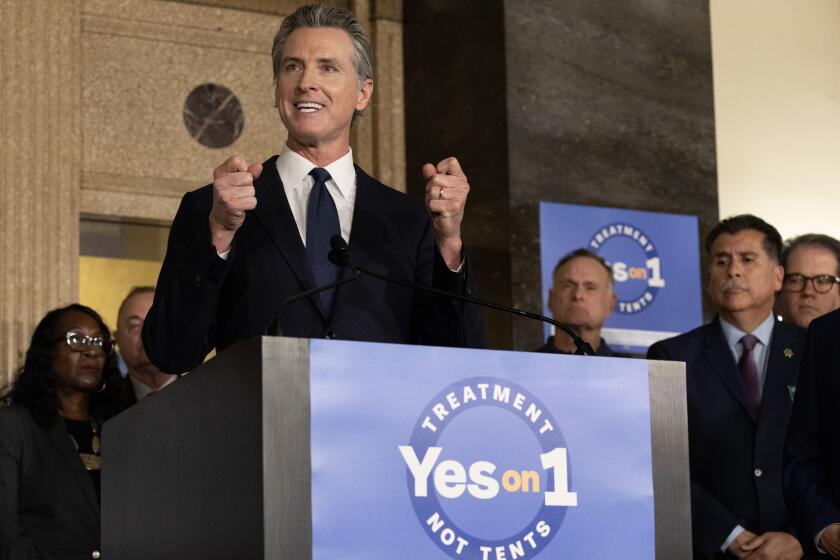Builder Seeks New Loan for Apartment Renewal Plan
The developer of a project to upgrade the Bryant-Vanalden area of Northridge has asked the city to lend him another $600,000 because of cost overruns and other unanticipated expenses.
Developer Devinder (Dave) Vadehra said Monday that he has run into a number of problems that have driven up the cost of the $25-million tax-supported redevelopment project.
One major problem, he said, is that he found 4,000 tenants living in a cluster of 40 buildings in the area--1,000 more than originally estimated. As a result, he said, he has had to wait longer than expected for units to become vacant so they can be renovated. Vadehra said the delays have forced him to extend the contracts of workers.
“We have quite a few cost overruns due to the delays that we experienced because of the tenants not moving out on time,” Vadehra said in an interview. “Those delays added to our costs because we could not produce as much work as we had planned to do.”
Mayor, Council OK Needed
The loan requires the approval of the Los Angeles City Council and Mayor Tom Bradley. It will come before the council’s Grants, Housing and Community Development Committee on Wednesday.
The Community Development Department has recommended approval of the loan. Ralph Esparza, director of the Community Development Department’s housing division, said that Vadehra’s “cash-flow problems” would not jeopardize the project. He added that he expects the project to be completed on schedule in September.
The council in December, 1986, voted to issue $20.8 million in tax-exempt bonds and lend another $4.2 million to Vadehra to buy and renovate 453 apartments in a three-block area crisscrossed by Bryant Street and Vanalden Avenue. The area long has been criticized for introducing crime and unsightly conditions to the surrounding middle-class neighborhood.
The plan would enable Vadehra to renovate the units and rent them at higher prices to recover the cost of improvements.
But, in a letter to the city, Vadehra said he has been left “desperately in need” of additional capital because he has not been able to fix up and re-rent as many units as expected. While more than half of the 4,000 tenants have left the area, 1,669 were in the apartments as of April 15, he said.
“They were supposed to cooperate with us and move out of the project,” Vadehra said. “Instead, they refused to move out and, to avoid bad publicity, everyone agreed to let them stay if they did not want to move. This brought our construction progress to a screeching halt.”
Vadehra blamed tenants’ refusal to move on the efforts of activists who suggested that tenants would not be allowed to return to their former units if they voluntarily moved out. But Vadehra stressed that tenants will be allowed to reoccupy their former units, if the units are available when the tenants want to move back in.
City officials and Vadehra had thought that many tenants would move out of the Bryant-Valaden area when offered rent subsidies to live elsewhere. The subsidies, provided under a federal program known as Section 8, reduce the amount of rent a lower-income resident must pay.
But many tenants refused to apply for rent subsidies. Many undocumented immigrants expressed concern that their applications for rent subsidies would jeopardize their applications for amnesty, even though city officials assured them that the status of their applications would not be affected.
Esparza speculated that many tenants chose to remain in their units once they saw improvement in the neighborhood.
Another problem, Vadehra said in the letter, is that even when units have been vacated and renovated, it has been difficult to rent them for a higher amount because middle-income tenants are “very reluctant to pay market-rate rents and live in a low-income project.”
“It was assumed that the large amount of vacancies created through attrition and the moving out of tenants by providing Section 8 certificates will be used to bring in market-rate tenants to change the character of the apartment complex,” Vadehra said.
So far, 145 of the 453 units have been renovated. Of these, 20 have been rented at market value. A one-bedroom renovated unit rents for $545 a month; a three-bedroom rents for $850. Thirty-three units have been rented to low-income tenants. Another 80 low-income tenants are waiting to qualify for rent subsidies so they can move into renovated units.
Vadehra said repair costs to some of the units have been higher than expected. About 200 units were destroyed, he said. “We had to go in and replace everything in those units.”
Vadehra, who said he is still preparing a list of the specific cost overruns, said he had to replace most of the stoves in the apartments. “We had assumed that most of the stoves were working,” he said. Many tenants had been cooking with electric frying pans, he said.
Councilman Hal Bernson--a proponent of the project, which is in his district--said he supports the loan. “I really don’t think we have too much of an alternative,” he said in an interview. “It’s very important to keep the project going.”
City officials reiterated their position that tenants who now live in Bryant-Vanalden area can receive rent subsidies to remain in the neighborhood.
The Times reported last December that dozens of current and former tenants complained that they were told they could receive subsidies only if they moved elsewhere, contrary to promises by the city. Indeed, many tenants moved elsewhere, often to crime-ridden, rundown areas in other parts of the San Fernando Valley.
No Proof
City officials have said that they have no proof that tenants were forced out. Representatives of Vadehra and city officials have suggested that the tenants moved out because they were confused.
But Walter Clarke, who monitors the project for the Community Development Department, acknowledged that the city has not interviewed tenants who have moved. He suggested that those tenants are probably better off because they are living in their own, larger apartments and paying less rent. “I don’t see them as having been adversely impacted,” he said.
Clarke said there is no limit to the number of tenants who can receive rent subsidies to stay in the Bryant-Vanalden area. He also said that any tenants who moved out of the Bryant-Vanalden area can receive subsidies to rent one of the renovated units. “They would be welcome as long as they were good tenants,” he said.
City officials said the developer has done away with a number of strict rules that tenants found difficult to live with.
Tenants, for example, had complained about having had to carry identification cards. The cards no longer are required, Clarke said. Tenants also were being charged a $25 penalty for every day they were late paying their rent. City rent-control director Barbara Zeidman warned Vadehra that such fees could not be charged unless they were part of a rent agreement between the tenants and the prior owners.
Since that warning, the city has agreed to a request by David Pallack, an attorney who has worked with the tenants, to send to tenants a letter explaining their rights.




